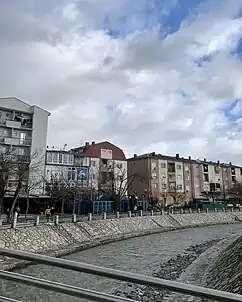Llapi River
The Llapi River[lower-alpha 1] is a river in the north-eastern part of Kosovo. The 72 km (45 mi) long right tributary to the Sitnica river, it is the main river in the Llap (region) depression.
| Llapi | |
|---|---|
 The Llapi river at Podujevo | |
| Physical characteristics | |
| Source | |
| • location | Pollatë, Podujevo, Kosovo |
| Mouth | |
• location | Lumadh, Vushtrri, Kosovo |
• coordinates | 42.7553°N 21.0172°E |
| Length | 72 km (45 mi) |
| Basin size | 950 km2 (370 sq mi) |
| Basin features | |
| Progression | Sitnica→ Ibar→ West Morava→ Great Morava→ Danube→ Black Sea |
Etymology
The etymology of the river's name is derived from a pre-Slavic form Alb that underwent linguistic metathesis within Slavic giving the final form as Lab.[1]
The name of the river was first used in Antiquity and the Middle Ages, but has been preserved in the New Age.[2]
Many scholars take the hydronym Lab as ancient and derive it from an alb-, from which lab-, alp- could come.[2] The phonetic form for Albanian speakers is Llap. In the Middle Ages, the form Lapia is found.[2]
History
Near its origin are the remains of one of the medieval palaces of Serbian King Milutin (1282-1321) called Vrhlab.[3][4]
Overview
The Llapi river originates in the Kopaonik Mountains of the northern Kosovo at an altitude of 744.2 m (2,442 ft) and its source is considered to be the village of Pollatë.[5] After descending from the mountains, it flows southward through Podujeva. Close to Pristina and Obiliq, the river turns westwards of its origin and joins the Sitnica river, in the village of Lumadh.[5] The width of the river changes due to the dynamics of rivers, it is around 9-12 meters at the hydrometric point in Lluzhan and it has a depth up to 1.2 m (3.9 ft), that varies based on the season and the location.[5]
References
- Županić, Niko (1936). Značenje barvnega atributa v imeny ,,Crvena Hrvatska’’. Etnolog. p. 362. "Na ozemlju Dukljaninovic Bete Hrvatske se je namreč nahajalo mesto Lab, a stara srbska država Raša se je po njem razprostirala ad Lapiam et Lap, kar gotovo meri na župo in reko Lab, pritok Sitnice na Kosovem polju. Tu je menda nastopila znana slovanska likvidna metateza alb > lab, ali je treba pripomniti, da so ti koreni predslovanski, morda celo predindoevropski, kakor n. pr. pri Labi na severu (Albis). [In the territory of Croatia's Dukljaninovic has a place located called Lab, but the old Serbian state Raša is after stretching to Lapi or Lap, which certainly is measured at the region and the Lab river, a tributary of Sitnica in Kosovo Polje. There is apparently a known Slavic metathesis alb> lab, or these pre-Slavic roots, perhaps even in pre Indoeuropean as n. pr. the Elbe in the north (Albis).]"
- Pulaha, Selami; Mansaku, Seit; Gjergji, Andromaqi (1982). Shqiptarët dhe trojet e tyre (in Albanian). Shtëpia Botuese "8 Nëntori".
- Zbornik zaštite spomenika kulture: Recueil des travaux sur la protection des monuments historiques. Publicističko-izdavački zavod Jugoslavija. 1965. p. 156.
In 1963 the author studied in the field and photographed the architectural remains of the palace of King Milutin at Vrhlab, at the source of the Lab river on the Kopaonik mountain.
- Radičević, Dejan (2017). "The Late Middle Ages in Light of Archeology". Artistic Heritage of the Serbian People in Kosovo and Metohija. Serbian Academy of Arts and Sciences. p. 276. ISBN 978-8-67025-758-0.
- "PLANI ZHVILLIMOR KOMUNAL 2016 - 2025" (PDF).

